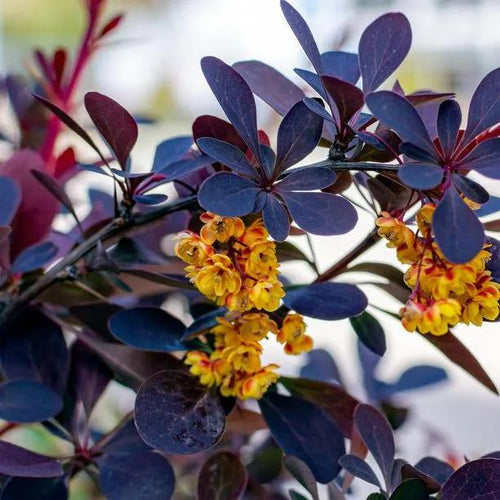Purple Barberry Hedge Plants
-
Use: Secure hedge, specimen shrub
-
Height: Up to 1.5m
-
Growth: Medium. Dense, thorny habit
-
Soil: Any well-drained soil
-
Light: Sun to partial shade
-
Type: Deciduous thorny shrub
-
Species: Berberis thunbergii Atropurpurea
- RHS Plants for Pollinators
-
Bareroot Delivery: Nov-March Only
-
Pot Grown Delivery: Year-round
Appearance, Growth & Uses
Berberis Atropurpurea is the purple-red leaved variety of Japanese Barberry. This medium-sized deciduous shrub creates an excellent prickly hedge or specimen with its vandal-proof spines and graceful arching stems.
Small yellow, pink-tinged flowers appear in April and May, attracting bees before developing into bright red berries in summer.
The distinctive small leaves are purple for most of the year, transforming into deep red in a striking autumn display, giving loads of ornamental value throughout the growing season.
It's quite shade-tolerant, perfect for hedges up to 1.5 metres high.
Features
Growing Conditions
-
Soil: Any well-drained including clay and chalk
-
Light: Full sun to partial shade
-
Moisture: Drought tolerant when established
-
Avoid: Full shade, waterlogged soils
-
Maintenance: Clips well, can be coppiced
-
Hardiness: Very hardy, coastal and urban tolerant
Thrives in any well-drained soil including heavy clay and chalk.
Tolerates coastal conditions and exposed windy spots well.
Quite shade tolerant and grows well in dappled shade under larger trees, though best colour develops in sunnier positions.
Can be prone to mildew on dry soils, prevent this by mulching well every year.
Garden Design Ideas
Creates an attractive backdrop with dramatic foliage colour that can be repeated through borders using other dark-leaved shrubs like Cotinus coggygria, Sambucus 'Black Lace' and Physocarpus 'Diabolo'.
The purple foliage combines beautifully with vibrant yellows of Rudbeckia 'Gold Star' and Achillea, and the purples of Salvia 'Amistad' and Lavender 'Hidcote'.
Specimen shrubs can be lightly trimmed in winter or coppiced to encourage brighter stem and summer foliage colour.
Perfect for mixed hedging with green berberis to create striking colour contrasts.
History & Trivia
Japanese Barberry was introduced to Europe in the 1860s and these red-purple forms were cultivated in the early 20th century.
The species is named after Carl Peter Thunberg, the Swedish naturalist who identified the shrub on a visit to Japan, where he was stationed at Dejima, a Dutch trading post in Nagasaki, from 1775-1776.
He described Japanese berberis in his Flora Japonica, published in 1784.

 Secure, One-Tap Checkout
Secure, One-Tap Checkout
 Hand Picked, Delivered to Your Door!
Hand Picked, Delivered to Your Door! 1 Year Bareroot Guarantee
1 Year Bareroot Guarantee






